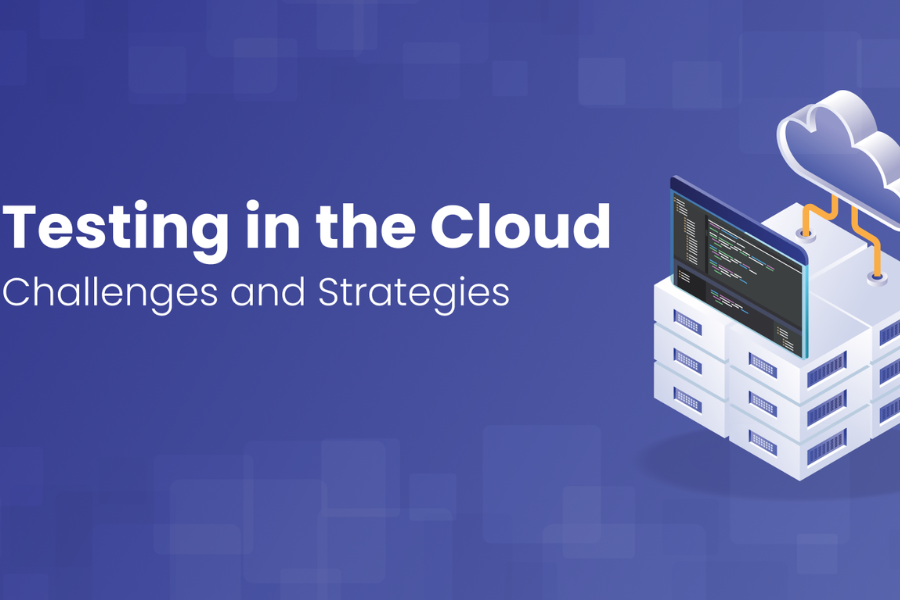Struggling to implement real device testing on your mobile applications? Yes? This is probably because you are still following the traditional method of having an on-site device lab and updating it manually to add all the new devices. So what’s the solution? You need to start investing in cloud testing solutions as they will help you achieve all your advanced goals while eliminating the disadvantages of a traditional setup.
However, to ensure a successful cloud-testing solution, you must have a well-planned approach which covers your business objectives, security considerations, and performance requirements.
Confused about creating your cloud testing strategy? Don’t worry! We are here for you. Our article will help you understand the major components of a cloud system strategy. We will also discuss the challenges, best practices, and all the tools associated with this process so that you can utilize its full potential.
What Is Cloud Testing
Let us not dive straight into the complex details of cloud testing. Let’s develop a basic understanding of what it is first. So, in simple terms, it is the process of using cloud-based environments to execute your test cases. You can also use this process to simulate real-world user conditions and validate the application’s performance on different devices, platforms, and network configurations.
Let us now divert our attention towards some of the major benefits of implementing cloud testing on the modern application testing workflow:
- This approach will help you to easily scale testing environments depending on the current requirements of your application development and testing projects.
- A cloud platform offers a pay-per-use model, which will help you to reduce the capital expenses that you will be traditionally spending on hardware and software requirements.
- Using a cloud environment, you can ensure that even with a distributed team, all the required team members can collaborate in real time so that the feedbacks are accessed quickly and resolved at the same time.
- By implementing automation testing within a cloud testing environment, you can massively speed up the overall test execution process to ensure that you are delivering high-quality software to your customers in a short time.
- Finally, with the cloud testing platform, you will have diverse test coverage so that you can include all your target browsers, operating systems, and devices. This is one of the most important factors to ensure that you are exclusively testing on your target audience’s preferences.
Key Components of a Cloud Testing Strategy
To implement cloud testing in a modern testing infrastructure, you need to implement the major components of this process. To simplify this process for the new testers, we have mentioned all the major components in this step. During our discussion, we’ll also mention how you can implement these components and all the tools that will be beneficial for each of these:
1. Defining Objectives and Scope
The first component is to properly define your strategy and also ensure that you can achieve your business goals with this process. While defining this process, you must ensure that it is answering the following questions:
- What types of testing will be required in the entire workflow? These can include functional, performance, security, and usability testing.
- What cloud service models are you aiming to use in the test execution process? Some of the common options include SaaS, PaaS, and LaaS.
- What are the key performance indicators that you will consider to define the success of the entire cloud testing infrastructure?
2. Selecting the Right Cloud Testing Tools
Selecting the right tool is the most important process in the entire strategy definition phase for cloud testing. This is because, with thousands of options available in the market, you need to find the particular tool that not only serves your specific requirements but also meets your revenue and resource goals.
Some of the common options in this regard include Selenium Grid, AWS device farm, and LambdaTest. To further understand the influence of the cloud testing platforms on the entire process, let us use the example of LambdaTest as our reference:
LambdaTest is an AI-native test orchestration and execution platform that lets you perform manual and automation testing at scale with over 5000+ real devices, 3000+ browsers, and OS combinations. You can also combine LambdaTest with Appium to execute automated cloud mobile testing. To further help you understand the execution process, we have attached a sample code snippet for the same:
3. Ensuring Security and Compliance
While you’re working on a cloud infrastructure, you must remember that you will be transferring sensitive customer information through the Internet. This becomes even more crucial while working on sensitive applications like health apps, banking apps, and e-commerce apps. Some of the major areas that we must implement in this process include:
- Data encryption to ensure that your sensitive customer information cannot be accessed by any third party service.
- Access control mechanisms to restrict unauthorized access. You must also implement access control mechanisms for the internal members as well to ensure that everybody has access to as much data as required depending on their role in the project.
- Compliance with industry regulations and standards. Some of the most important names in this regard include GDPR, HIPAA, and ISO.
- Secure API testing to ensure that you do not have any severe security vulnerabilities within the infrastructure of the application. This process will help prevent any form of security breach or forced access to the source code of the application.
4. Designing Scalable and Reliable Test Environments
While working in a cloud setup, you must ensure that the entire environment can mimic all the real-world conditions that your users will be implementing. This approach will ensure the accuracy and dependability of the entire test report. Some of the major considerations that you must implement include:
- Virtual machines and containers to create isolated testing environments. This approach will ensure that all the tests are independent and are not influenced by the results of the previous or next test report.
- Automated testing provisioning of test environments using infrastructure as code. You can easily implement this process by using tools like Terraform.
- Network simulation tools to test the functioning of the application under various network conditions like low bandwidth or unstable latency.
5. Automating Cloud Testing
In a complex app development scenario like modern apps, automation testing will be very important, even with a cloud environment.
You must implement continuous integration and continuous deployment pipelines to ensure faster feedback loops and simultaneous execution of testing and development.
You can also use test orchestration tools like Jenkins, CircleCI, and GitHub Actions for ensuring proper test management. It is also important to implement parallel testing with these steps.
6. Performance and Load Testing in the Cloud
Use your chosen cloud solution to understand the application’s performance under different user loads or unusual traffic. For this, you can use tools like Apache JMeter, Gatling, or LoadRunner.
7. Continuous Monitoring and Reporting
Finally, you must implement real-time monitoring and reporting to measure the performance metrics and implement necessary changes. Tools like New Relic, Data Dog, or Prometheus will be useful for monitoring.
You can also consider setting up alert mechanisms for various bugs or major performance issues. It is also important to create and maintain detailed test reports for debugging and also future reporting.
Overcoming Cloud Testing Challenges
Although cloud testing comes with multiple benefits, it also has its own share of challenges that you must overcome during the test implementation process. To shed more light over this segment, we have mentioned some of the major challenges below:
- The primary infrastructure of cloud testing depends on your network configuration to send and receive data. You must use graphically distributed test servers to mimic real-world testing scenarios.
- While you are sending sensitive customer information over the cloud, there will be certain security concerns in the process. So it is very important to implement strict authentication, encryption, and data protection policies in this step.
- It can be a complex process to integrate certain tools in the cloud testing process. So, we suggest the testers to choose cloud tools that have APIs and also easy integration for continuous deployment and continuous integration airplanes.
- Finally, you also have to deal with multiple data privacy concerns while working with the remote infrastructure. You can easily mitigate this issue by storing the test data in compliance with regional laws and also using anonymization techniques so that the data cannot be directly linked to your customers.
Best Practices for Implementing a Successful Cloud Testing Strategy
Finally, we suggest the testers implement the following best practices with their cloud testing framework to ensure its proper productivity and also a better quality of the application:
- It is very important to adopt a hybrid testing approach that will combine on-premise and cloud environments. The specific goal for this practice is to optimize security and also the cost of the entire testing infrastructure.
- We suggest the testers prioritize the automation testing process as it will help you to wrap up the test cases and also improve the efficiency and accuracy of the overall testing process.
- It is also important to utilize the capabilities of artificial intelligence and machine learning for enhancing test case selection and bug detection. AI will also help you to implement automated test healing so that it can adapt depending on the changing requirements of the application.
- You must use parallel and distributed testing techniques for faster test execution and also ensure that none of the elements of the application is being untested.
- Finally, it is very important to implement a continuous review and improvement cycle. By implementing this approach, you can ensure that you are continuously adapting to the evolving techniques and business requirements in this market.
The Bottom Line
Based on all the factors that we have put forward in this article, we can easily say that implementing a successful cloud testing strategy will require careful planning for tool selection, automation, and continuous monitoring. By using all the strategies and best practices that we have mentioned in this article, you can easily implement these parameters to achieve scalability, cost-effectiveness, and improved test coverage.
You should also remember that the market for cloud testing will continue to evolve and will require you to embrace innovative testing solutions and integrate artificial intelligence-driven testing platforms to improve efficiency and software quality. Factors like these will be very important to maintain a positive brand reputation and help you speed up the test release cycle.



